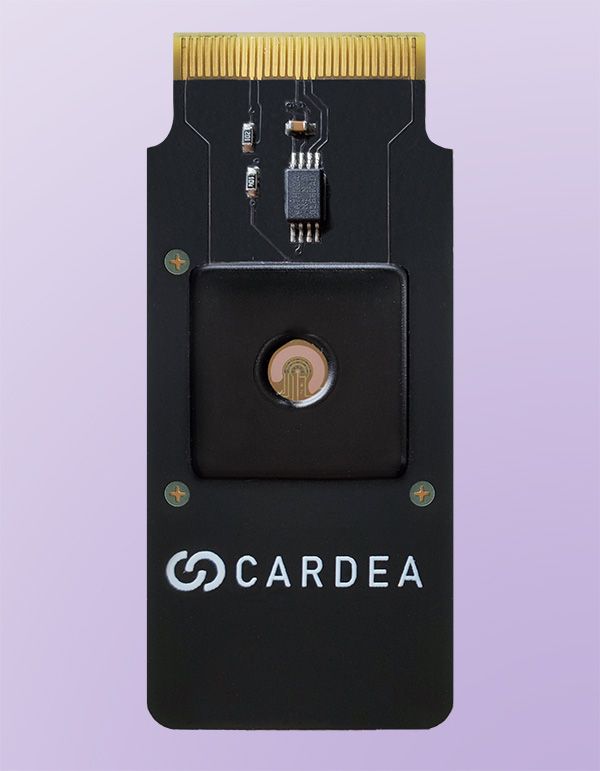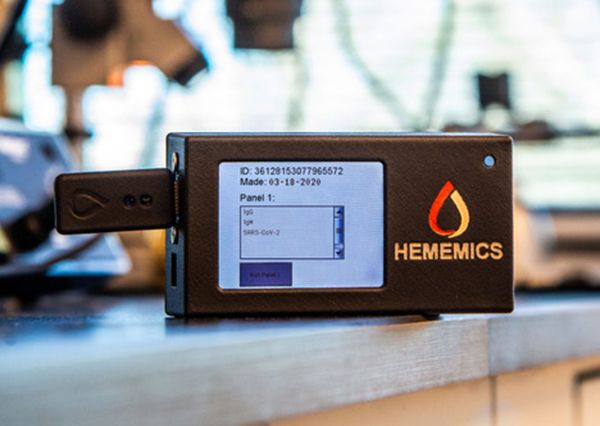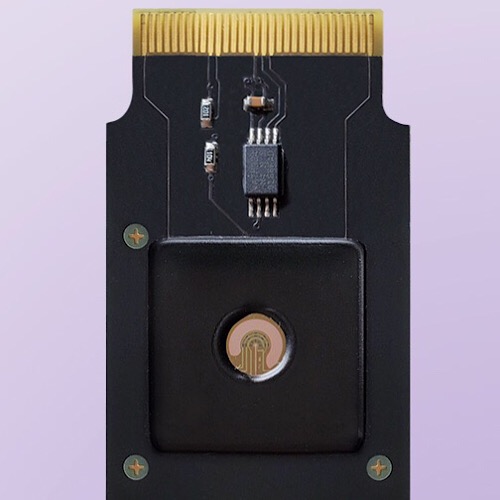You prick your finger or swab your nose and dab a tiny sample of the fluid onto a semiconductor chip. Slot that chip into an inexpensive, handheld reader and, within a minute or so, its small screen displays a list of results—you are negative for the new coronavirus, positive for antibodies. The likelihood of false results is extremely low. You are cleared to enter your company’s building or fly on a plane.
This sort of fast, on-the-spot testing is just a dream right now. Most tests available today to see if people have the virus are conducted using reverse transcription polymerase chain reaction (RT-PCR) technology. This process looks for a specific sequence of RNA in the sample—in this case, a sequence unique to the coronavirus. Then it copies that sequence repeatedly by adding different chemicals and cycling the temperature of the solution. A fluorescent molecule is attached to each copy; when enough RNA copies accumulate, the sample will glow when hit by a light. Most of these tests, however, require a lab to process. The necessary chemicals are in short supply, and the fastest tests—those that produce results in under 15 minutes—struggle with false negatives.
Then there are antibody tests, also called serology tests. These can only determine if someone has had the virus in the past, not whether they are currently sick. They measure whether the patient’s immune system has started creating antibodies against a specific virus, using blood from a standard blood draw or a small sample from a finger prick. Antibodies in the blood bind to a protein embedded in a test strip as the sample wicks along the strip, triggering color changes that display a result, working much like a pregnancy test stick. More than 100 antibody tests for the coronavirus have been introduced, but their accuracy varies.
Newer antigen tests for the active virus look for fragments of the coronavirus’ characteristic spike protein in a sample from a nasal swab. These are less sensitive than PCR tests but give much faster results. The FDA just started approving these in May.
These tests all have their tradeoffs. So what would it take to make a test that’s fast, accurate, and low-cost?
The Magic of Biosensor Chips
The answer, says Jessica Gomez, cofounder and CEO of Rogue Valley Microdevices, may come from biosensor chips. Rogue Valley Microdevices is a wafer foundry that specializes in manufacturing microelectromechanical systems (MEMS) and sensors. And, she says, the company is working with several startups scrambling to produce biosensors for coronavirus testing.
Two of those companies—Cardea Bio and Hememics—are talking publicly about their work. The chips they’re developing have many similarities and a few differences.
Biosensors used for viral RNA, antibody, or antigen detection all rely on semiconductor circuitry coated in a biological material that will attract—and bind with—the biological material of interest in a sample fluid. When such bonds occur, the flow of electrons through the circuit noticeably changes. They are structured much like silicon MOS field-effect transistors with a source and a drain and a gate between them. But in the sensors, the gate is controlled by the binding of biomolecules instead of a voltage signal—a bioFET.
Biosensors do not require that any material be multiplied to generate a signal, or that the biological sample go through multiple lab processing steps. This means tests can be extremely fast, running in under 60 seconds. And because a chip can contain multiple circuits, multiple tests of different kinds (viral RNA, antibody, and antigen) can run simultaneously on the same chip—the only requirement is that different biological substances act as detectors for different circuits. This could allow the system to hunt for a wide variety of RNA fragments, antibodies, and antigens—not just the most likely one. Such an approach could reduce false results and provide additional information about a patient’s health, perhaps by testing for the flu and the new coronavirus at the same time.
The biosensors under development by Cardea and Hememics rely on graphene and carbon nanotubes, respectively, that in both cases are used as semiconductors. Unlike silicon, these materials do not degrade when they come in contact with a biological fluid. And they have a speed advantage, a good thing in a situation where the signal changes that occur are very small.
Cardea Bio’s Crispr on a Chip
For RNA detection, Cardea’s special sauce is its use of molecules from the Crisprtechnology as a biological detector. The company has been working since 2013 to build a programmable biosensor platform that allows detection of DNA, RNA, proteins, and other molecular signals, says Cardea CEO Michael Heltzen. In January of 2019, Heltzen says, Cardea was ready to begin working with commercial partners to develop the first products based on its platform; it published a paper on the technology and basically opened its doors for business.

By the end of 2019, Heltzen says, Cardea had interest from 88 companies. While most of them are still in the designing and development phase, one—COBO Technologies—has announced publicly that it will use the Cardea platform in a system for quality control of genome engineering for pharmaceutical drug development.
Then, of course, the coronavirus pandemic got the world’s attention. Says Heltzen, “A lot of people reached out to us to ask if they could use our technology to detect the coronavirus without amplification using Crispr.” While Cardea had intended to provide a platform for applications developed by others, Heltzen says, with so many companies wanting to build coronavirus biosensors, Cardea decided to develop the tests for detection of the SARS-Cov-2 viral RNA, relevant antibodies, and relevant antigens itself. “By working on it in our lab, we can distribute it to many partners and get it out faster,” he says.
“If you had asked me six months ago,” Heltzen says, “I would have said that we won’t touch anything involving human diagnostics for a couple of years; we want to focus on being a platform and running our production, we don’t want to get into regulatory complexities. But now, everything is turned upside down.”
Cardea has been working on the Crispr test for the virus for several months; work on the antibody and antigen tests began more recently.
“The tests are preforming well,” Heltzen says, but are “still being optimized. The biggest hold back at the moment is to scale from mass production (tens of thousands of chips per month) to extreme mass production (tens of millions and, with time, hundreds of millions of chips per month).” Heltzen said the company is in discussions with large companies, investors, and governmental organizations for financial and other support.
Dry Proteins Are Hememics’ Special Sauce
Hememics’ special sauce is its ability to preserve biological materials in a dry form. The company launched in 2007 to develop a technology for drying blood products that uses a preservative containing various sugars to allow these substances to stay viable after being dried. In 2015, it started applying its preservation technology to other types of proteins, including antibodies and peptides, for use in biosensors.

Explains Hememics CEO John Warden, dry biological materials are more easily integrated into a biosensor than wet ones, and they stay stable longer. “Our dry protein mix sits on top of the semiconductor, waiting for a wet sample,” he says. “If you want biology to be married to electronics, preservation is the key to that marriage, so [that] you can keep the device stable at ambient temperature.”
With an investment from Inova, a network of hospitals in the southeastern United States, Hememics has been lately aiming to use its biosensor technology to detect hospital-acquired infections, conducting several small trials.
Then coronavirus happened, and, says Warden, “We flipped the chip. We had been putting antibodies on the chip looking for proteins, now we are putting proteins on the chip and looking for antibodies.”
The version of the chip in development right now, Warden said, will have 32 sensing circuits on it. “We think we are five or six weeks away from our final design,” he says.
“We will be able to test for protein number four, say, on one circuit, protein 16 on another, etc., and change the way the microcontroller assimilates the data from all the different channels to optimize for both sensitivity and specificity,” he says. The technology can be used to test for the virus or the antibodies, or—in the case of a saliva sample—both simultaneously, he says.
Getting any kind of biosensor for the coronavirus to a mass market will take money—lots of it. Any test needs to be tested with multiple patients against existing technology and be approved by the U.S. Food and Drug Administration for emergency use; only then will manufacturing capacity be ramped up.
Cardea has raised US $10 million to develop its technology, and is in the middle of a new funding round. The company’s biosensor for the new coronavirus could be ready for mass production by the fourth quarter of 2020, Heltzen says, but actually making large-scale production happen would require a capital infusion from either government or large investors.
Hememics has raised $2.5 million from AMVI Partners and hopes to receive an additional $3 million from the same investment firm. The company likewise believes it could have biosensors for coronavirus testing to market by the end of 2020.
Rogue Valley Microdevices has already started manufacturing sensor chips for both Cardea and Hememics. Gomez says maintaining the surface chemistry of the devices is critical, and the company is working to develop a manufacturing process that does so and can be transferred to other manufacturers to quickly increase capacity if necessary.
“There needs to be a very robust supply chain to ensure health care providers have an adequate supply of the tools they need in the field,” Gomez says. “We’re really excited about the potential biosensors have of bringing [as] many accurate options for coronavirus testing as possible.”
Source: spectrum









